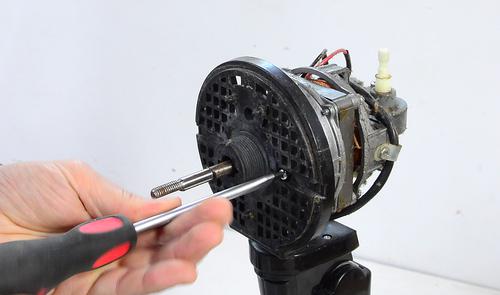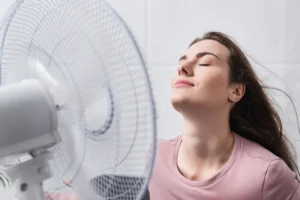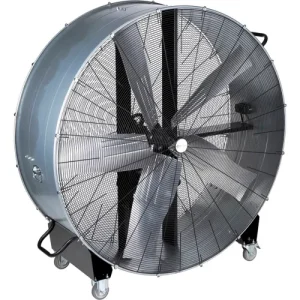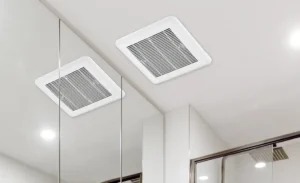Industrial fans are essential cogs in the machinery of many factories and large spaces.
But what powers these fans and ensures they run smoothly? The answer: electric motors.
While these motors are designed for durability and efficiency, they aren’t immune to issues.
When problems arise, the performance of the entire fan can be compromised, affecting the overall operation of a facility.
Understanding the common challenges faced by electric motors in industrial fans is crucial.
Not only does it help in timely troubleshooting, but it also aids in preventive maintenance, ensuring longer fan life and consistent performance.
In this guide, we’ll delve into the typical issues these motors encounter, offering simple explanations and solutions.
Whether you’re a facility manager, technician, or just curious, this guide aims to provide clarity on a topic that’s vital yet often overlooked. Let’s dive in!
How Long Do These Motors Last?
The lifespan of electric motors in industrial fans is a topic of interest for many, especially those in charge of maintaining and managing industrial facilities.
These motors, much like the heart in our bodies, keep the fans running, ensuring optimal ventilation and air circulation.
On average, a well-maintained electric motor can run smoothly for about 40,000 hours.
However, this figure isn’t set in stone. Several factors can influence a motor’s lifespan:
Maintenance: Just as regular check-ups can keep us healthy, routine maintenance can extend a motor’s life. This includes periodic inspections, lubrication, and addressing minor issues before they escalate.
Operating Conditions: Motors that operate in clean, cool environments tend to last longer. In contrast, those exposed to excessive dust, heat, or moisture may face a reduced lifespan due to wear and tear from these harsh conditions.
Usage: A motor that runs continuously at high loads will likely wear out faster than one used intermittently or at lower loads. It’s similar to how a car with high mileage might face more issues than one driven sparingly.
Quality of the Motor: Not all motors are created equal. High-quality motors, built with superior materials and craftsmanship, are naturally poised to outlast their cheaper counterparts.
In conclusion, while there’s an average lifespan associated with electric motors, the actual duration can vary based on maintenance, usage, environment, and the motor’s inherent quality.
By understanding these factors, one can take proactive steps to ensure the motor’s longevity, ensuring the industrial fan continues to function efficiently for years to come.
Dust and Dirt – Not a Motor’s Best Friend
In the bustling environment of industrial operations, dust and dirt are often inevitable byproducts. But for the electric motors that power industrial fans, these seemingly harmless particles can be detrimental.
Impact on Performance: Dust and dirt can settle on the motor’s components, effectively acting as an insulating layer. This can hinder the motor’s ability to dissipate heat, leading to potential overheating. An overheated motor might not only see reduced efficiency but could also risk premature failure.
Wear and Tear: The fine particles of dust and dirt can be abrasive. When they infiltrate the motor’s moving parts, they can accelerate wear and tear, potentially leading to unexpected breakdowns.
Blockages: Motors often rely on cooling mechanisms like vents or fans. Accumulated dust and dirt can clog these systems, reducing airflow and further intensifying the overheating issue.
Increased Maintenance Costs: A motor consistently exposed to these particles will inevitably require more frequent maintenance. This can translate to more cleaning, part replacements, and overall higher operational costs.
Safeguarding the Motor: While it’s challenging to completely eliminate dust and dirt in industrial settings, there are measures to reduce their impact. Using protective covers, ensuring the facility has effective filtration, and regular cleaning can help. Additionally, opting for sealed motor variants can offer an added layer of protection against these pesky particles.
By understanding the challenges posed by dust and dirt and taking proactive steps, we can ensure the longevity and efficient performance of electric motors in industrial fans.
Keeping Motors Cool
The electric motors in industrial fans, much like any other machinery, have an optimal temperature range where they operate most efficiently.
Keeping them cool is not just about ensuring their immediate performance but also about prolonging their lifespan.
Here’s a deeper look into the importance of temperature regulation and ways to achieve it:
The Risks of Overheating: When motors run hotter than they should, they risk damaging their internal components. Overheating can degrade the insulation around the motor windings, leading to electrical shorts. It can also expand internal parts, causing friction or misalignment. Over time, these issues can lead to reduced motor efficiency, increased energy consumption, and even complete motor failure.
Sources of Heat: Several factors can contribute to a motor’s temperature. Continuous operation, especially under heavy loads, naturally generates heat. External factors, such as the ambient temperature of the environment where the motor is placed, can also play a significant role. Additionally, issues like friction from misaligned parts or worn-out bearings can produce extra heat.
Cooling Mechanisms: Most electric motors come equipped with built-in cooling systems. These can be in the form of cooling fins, fans, or even liquid cooling systems for more high-end models. These mechanisms help dissipate the heat generated during operation, ensuring the motor remains within its optimal temperature range.
External Cooling Solutions: In environments where the built-in cooling systems might not suffice, external cooling solutions can be employed. This could include placing the motor in a shaded or climate-controlled area, using external fans, or even incorporating cooling jackets or pads.
Regular Monitoring: One of the best ways to ensure a motor remains cool is by regularly monitoring its temperature. This can be done using infrared thermometers, thermal cameras, or temperature sensors. By keeping a close eye on temperature trends, potential overheating issues can be identified and addressed before they escalate.
Ensuring that electric motors remain cool is a blend of proactive monitoring and employing effective cooling strategies.
By prioritizing temperature regulation, we can optimize the performance and longevity of motors in industrial fans.
Making Small Changes for Better Performance
Electric motors powering industrial fans are designed for efficiency and durability. However, there’s always potential to boost their performance.
Surprisingly, minor tweaks can lead to noticeable improvements.
Here’s a closer look at practical adjustments that can make a difference:
Calibration and Settings: Motors have specific settings that, when adjusted, can optimize their performance. For instance, tweaking voltage levels or operating frequencies can ensure smoother and more efficient operation.
Lubrication: Regularly oiling or greasing the motor’s moving parts can significantly reduce friction. It’s essential to use the right type of lubricant and apply it in the correct amounts to avoid complications.
Alignment Checks: Ensuring that the motor’s components are properly aligned can prevent unnecessary wear and tear. Regular checks and adjustments can keep everything in sync and running smoothly.
Upgrading Components: Consider replacing older parts with newer, more efficient ones. For example, if a motor’s bearings are worn out, installing modern, low-friction bearings can enhance its performance.
Protective Measures: Simple additions like surge protectors can shield the motor from electrical spikes. Using protective covers or mesh screens can also help keep out dust and debris, ensuring a cleaner operational environment.
Feedback Systems: Installing sensors that monitor temperature, voltage, or current can provide valuable insights into the motor’s performance. This real-time data can guide timely interventions, ensuring the motor always operates at its best.
By focusing on these practical and straightforward adjustments, the performance of industrial fans can be significantly improved.
It’s a clear indication that with a bit of attention and care, even small changes can lead to better results.
Taking Care of Motors
Electric motors are the driving force behind industrial fans, ensuring they operate efficiently and effectively.
Like any piece of machinery, these motors require regular care and attention to maintain their performance and extend their lifespan.
Here’s a guide to ensuring they remain in top condition:
Routine Inspections: Regularly checking the motor for signs of wear, damage, or any unusual noises can help identify potential issues before they become significant problems. This proactive approach can prevent costly repairs or replacements down the line.
Cleanliness: Keeping the motor clean is essential. Over time, dust, dirt, and other contaminants can accumulate, leading to reduced efficiency and potential overheating. Periodic cleaning, especially in dust-prone environments, can help maintain optimal performance.
Lubrication: Motors have moving parts that require lubrication to reduce friction and wear. It’s crucial to use the right type of lubricant and apply it at regular intervals. Over-lubricating or using an incorrect lubricant can cause its own set of problems, so always follow the manufacturer’s guidelines.
Temperature Monitoring: Overheating is a common issue with electric motors. By regularly monitoring the motor’s temperature, either manually or with sensors, one can ensure it operates within safe limits. If a motor consistently runs hot, it might be a sign of an underlying issue that needs addressing.
Ensure Proper Ventilation: Motors need adequate airflow to dissipate heat. Ensuring they’re placed in well-ventilated areas or using external fans can help maintain a cooler operating environment.
Regular Maintenance: Beyond daily or weekly checks, it’s essential to schedule more thorough maintenance sessions. This could involve checking the electrical connections, testing the motor’s efficiency, or even replacing worn-out parts.
Stay Updated: Technology and best practices evolve over time. Staying updated with the latest maintenance techniques or advancements in motor technology can offer insights into better care and potential upgrades.
By dedicating time and effort to the care of electric motors, we can ensure the industrial fans they power continue to operate efficiently, providing the necessary ventilation and cooling that industrial spaces require.
Improving Motors
Electric motors, while designed for durability and efficiency, can benefit from periodic upgrades and enhancements.
As technology advances and operational demands change, finding ways to improve these motors can lead to better performance, reduced energy consumption, and longer lifespans.
Here’s how we can elevate the performance of our motors:
Upgrading Components: Over time, certain parts of a motor, like bearings or brushes, might wear out or become outdated. Replacing them with newer, more efficient components can boost the motor’s performance and reduce wear.
Energy-Efficient Models: Consider transitioning to energy-efficient motor models. These are designed to consume less power while delivering the same or even better performance, leading to cost savings in the long run.
Cooling Systems: Enhancing or upgrading the motor’s cooling system can prevent overheating, a common cause of motor failure. This could involve adding external fans, improving ventilation, or even incorporating advanced cooling solutions like liquid cooling.
Advanced Control Systems: Modern control systems can optimize motor performance by adjusting speed, torque, and other parameters in real-time. Integrating such systems can lead to more efficient operation and adaptability to varying loads.
Regular Training: As technology evolves, ensuring that maintenance personnel are trained in the latest motor care and improvement techniques is crucial. This knowledge can be instrumental in identifying areas of improvement and implementing them effectively.
Feedback Mechanisms: Incorporating sensors and feedback mechanisms can provide real-time data on the motor’s performance. This information can be invaluable in making informed decisions about potential upgrades or adjustments.
Protective Measures: Enhancing the motor’s protection against external factors like dust, moisture, or electrical surges can prolong its life. This could involve adding protective casings, surge protectors, or even moisture-resistant coatings.
Software Upgrades: For motors integrated with digital control systems, software upgrades can introduce new features, improve efficiency, and address known issues. Staying updated with the latest software versions ensures the motor operates at its best.
Why Do Some Motors Stop Working?
Electric motors are intricate devices that, despite their robust design, can sometimes falter or stop working altogether.
Understanding the reasons behind these failures is crucial for prevention and timely intervention.
Here’s a breakdown of common causes and the underlying issues:
Wear and Tear: Like all machinery, motors have a finite lifespan. Continuous operation, especially under heavy loads, can lead to natural wear and tear of components. Over time, parts like bearings, brushes, or windings can degrade, affecting the motor’s performance.
Overheating: A prevalent issue with motors is overheating. This can result from blocked cooling systems, continuous operation without breaks, or operating in high-temperature environments. Overheating can damage the insulation around motor windings and other internal components.
Electrical Overloads: Subjecting the motor to loads beyond its capacity can lead to electrical overloads. This can cause the motor windings to burn out, rendering the motor inoperative.
Poor Maintenance: Neglecting regular maintenance and inspections can lead to undetected issues escalating into significant problems. Dust accumulation, lack of lubrication, or unaddressed minor faults can culminate in motor failure.
Voltage Fluctuations: Motors are designed to operate within specific voltage ranges. Exposing them to consistent voltage spikes or drops can damage the internal components, leading to reduced efficiency or complete failure.
Environmental Factors: Motors operating in environments with high moisture, corrosive chemicals, or excessive dust are more prone to failures. These external factors can lead to rusting, short circuits, or degradation of components.
Mechanical Stresses: Misalignment, imbalances, or external physical stresses can lead to mechanical issues in the motor. These stresses can cause components to warp, break, or wear out prematurely.
Manufacturing Defects: While rare, manufacturing defects or design flaws can be a cause of motor failures. These might include subpar materials, improper assembly, or design oversights.
Understanding these common causes of motor failures provides a roadmap for preventive measures and maintenance strategies. By addressing these issues proactively, the lifespan and efficiency of electric motors can be significantly enhanced, ensuring they continue to power industrial fans reliably.
In Conclusion
Electric motors, the driving force behind industrial fans, play a pivotal role in ensuring smooth and efficient operations in various industrial settings.
Their significance cannot be understated, as they directly impact air quality, temperature regulation, and overall workplace safety.
Throughout this guide, we’ve delved into the intricacies of these motors, from understanding their lifespan and the challenges posed by environmental factors like dust and dirt, to the importance of keeping them cool and the myriad reasons they might falter.
We’ve also highlighted the value of making small yet impactful changes to boost their performance and the necessity of regular care and maintenance.
The world of industrial operations is vast and complex, and electric motors are just one component. However, their role is undeniably crucial.
By understanding their workings, challenges, and care requirements, we equip ourselves with the knowledge to ensure their longevity and optimal performance.
This not only translates to better operational efficiency but also contributes to a safer and more productive industrial environment.
Armed with this knowledge, we can navigate the challenges of industrial operations with confidence and foresight.




